#Random Element Selection in Python
Explore tagged Tumblr posts
Text
Day-4: Unlocking the Power of Randomization in Python Lists
Python Boot Camp 2023 - Day-4
Randomization and Python List Introduction Randomization is an essential concept in computer programming and data analysis. It involves the process of generating random elements or sequences that have an equal chance of being selected. In Python, randomization is a powerful tool that allows developers to introduce an element of unpredictability and make programs more dynamic. This article…

View On WordPress
#Advantages of Randomization in Programming#Dynamic Python Applications#Enhancing User Experience with Randomization#Generating Random Data in Python#How to Shuffle Lists in Python#Python List Data Structure#Python List Manipulation#Python programming techniques#Random Element Selection in Python#Randomization in Python Lists#Randomized Algorithms in Python#Secure Outcomes with Randomization#Unbiased Outcomes in Python#Understanding Non-Deterministic Behavior#Versatility of Randomization in Python
0 notes
Text
The Cost of Developing Gambling Applications: Factors, Trends, and Investment Considerations
The gambling industry has seen a significant shift toward digital platforms, with mobile and web applications becoming the primary channels for users to engage in casino games, sports betting, and other forms of online gambling. However, developing a gambling application is a complex and resource-intensive process that involves a wide range of technical, regulatory, and design considerations. As a result, the cost of building a gambling app can vary significantly, depending on factors such as feature complexity, technology stack, regulatory compliance, and user experience design. Understanding these factors is essential for stakeholders looking to invest in this lucrative but challenging market.
One of the primary drivers of cost in gambling app development is the feature set. Basic gambling apps with standard features like user registration, payment processing, and a limited selection of games can cost anywhere from
50
,
000
t
o
50,000to100,000. However, more advanced applications that include live betting, real-time multiplayer games, AI-driven recommendations, and blockchain integration can easily exceed $500,000. Features like push notifications, gamification elements (e.g., leaderboards and rewards), and social sharing also add to the development cost but are essential for enhancing user engagement and retention. Additionally, the integration of APIs for third-party services, such as payment gateways and game providers, can further increase expenses.
The choice of technology stack is another critical factor that influences the cost of developing a gambling app. For the frontend, frameworks like React, Angular, or Vue.js are commonly used to create dynamic and responsive user interfaces. These frameworks offer a high degree of flexibility and performance but require skilled developers, which can drive up labor costs. On the backend, technologies like Node.js, Python, or Ruby on Rails are often used for their scalability and efficiency in handling real-time data and transactions. The use of cloud-based infrastructure and Content Delivery Networks (CDNs) can also add to the cost but is essential for ensuring high availability and performance, especially during peak traffic periods.
Regulatory compliance is a major cost factor in gambling app development, as the industry is subject to stringent legal requirements. Developers must ensure that their applications comply with regulations such as GDPR, PCI DSS, and AML (Anti-Money Laundering) standards. This often involves implementing KYC (Know Your Customer) procedures, two-factor authentication (2FA), and end-to-end encryption (E2EE) to protect user data and prevent fraud. Additionally, gambling apps must undergo rigorous testing and certification to ensure the fairness and integrity of their games, particularly when using Random Number Generators (RNGs). These compliance measures can significantly increase development costs but are essential for obtaining licenses and building user trust.
User experience (UX) design is another area where costs can escalate. A well-designed gambling app must offer an intuitive and engaging interface that keeps users coming back. This often involves creating custom animations, interactive elements, and personalized dashboards, all of which require skilled designers and developers. Additionally, the app must be optimized for cross-platform compatibility, ensuring a seamless experience across iOS, Android, and web browsers. The use of UI/UX design tools like Figma or Sketch can help streamline the design process, but the need for high-quality graphics and responsive layouts can still drive up costs.
Ongoing maintenance and updates are another significant cost consideration. Gambling apps require regular updates to fix bugs, add new features, and stay compliant with changing regulations. This often involves continuous integration and continuous deployment (CI/CD) pipelines, which automate the testing and deployment of code updates. Additionally, developers must monitor the app’s performance and security, using tools like web application firewalls (WAFs) and SSL/TLS certificates to protect against threats. These ongoing costs can add up over time but are essential for maintaining the app’s competitiveness and user trust.
In conclusion, the cost of developing a gambling application is influenced by a wide range of factors, from feature complexity and technology stack to regulatory compliance and user experience design. While the initial investment can be substantial, the potential rewards are significant, given the growing demand for online gambling platforms. By carefully considering these factors and making informed decisions, stakeholders can develop a high-quality gambling app that meets user expectations and complies with industry standards. As the digital gambling landscape continues to evolve, investing in a well-designed and secure application will be key to achieving long-term success in this competitive market.
Make order from us: @UICAstudent
Our portfolio: https://www.linkedin.com/company/chimeraflow
0 notes
Text
Building a Ludo Game with Real Money Betting Features

Overview of the Development of Ludo Games
People of all ages love playing the well-known board game Ludo. But as internet gaming has grown in popularity, the classic board game has evolved into a captivating virtual experience. Because it provides an intriguing combination of strategy, competition, and the chance to win real money, Ludo game development with real money betting features is becoming more and more popular these days. We will examine how to create a Ludo game with real money betting elements in this post, going over crucial topics including technological specifications, security protocols, and revenue-generating tactics.
Important Elements of a Real Money Betting Ludo Game
A Ludo game needs essential elements that improve security and user experience in order to succeed in the competitive gaming market. Among the most crucial characteristics are:
Players can compete against actual people all over the world in multiplayer mode.
Secure Payment Gateways: Include dependable payment methods like cryptocurrencies, PayPal, and UPI.
Anti-Fraud Mechanisms: To guarantee fair play, use AI-driven fraud detection systems.
User-Friendly Interface: Make your UI/UX design interesting and simple to use.
Live Chat and Support: Facilitate instant communication and client service.
Create a random number generator (RNG) using the fair play algorithm to guarantee objective results.
Technical Elements of Developing Ludo Games
Selecting the Proper Tech Stack
Building a high-performing Ludo game requires careful consideration of the technology stack. Among the suggested technologies are:
Frontend: HTML5, JavaScript, Unity, and Cocos2d
Backend: PHP, Python, and Node.js
Database: Firebase, MongoDB, and MySQL
Security features include two-factor authentication (2FA) and SSL encryption.
Implementing Real-Time Multiplayer
To keep users interested, a smooth real-time multiplayer experience is essential. Cloud servers and WebSockets can be used to effectively synchronize gaming. To link players with comparable skill levels, AI-based matchmaking can also be used.
Integration of Secure Payments
Integrating secure payment gateways is crucial to guaranteeing safe and easy transactions. User trust is increased with support for many payment methods, including UPI, PayPal, Stripe, and cryptocurrency wallets. A safe betting experience is also guaranteed by adherence to gaming and financial rules.
Strategies for Ludo Betting Game Monetization
When a Ludo game has real money betting features, there are several methods to make money. Among the successful monetization techniques are:
Entry Fees & Commission: Each game has a minor entry cost, and a commission is deducted from the prize fund.
Sponsorships & Advertising: Show tailored advertisements to make money.
Premium avatars, dice designs, and boosters are available through in-game purchases.
Models for Subscriptions: Offer VIP memberships with special advantages.
Legal Aspects and Compliance
Following gaming rules and compliance standards is essential before opening a Ludo game with real money betting. Important things to think about are:
acquiring a gaming license in states where gambling is permitted.
putting in place guidelines for healthy gaming to stop addiction.
guaranteeing data privacy and adherence to other laws, including the GDPR.
Including KYC (identity verification) to stop fraud and gaming by minors.
How to Create a Ludo Game with Betting Elements
1. Market research and planning
Prior to growth, it is essential to comprehend the target audience and market need. Analyze competitors to find USPs (unique selling points).
2. Improving User Experience through UI/UX Design
Player engagement is increased with an interface that is both aesthetically pleasing and simple to use. For a flawless gaming experience, make sure PC and mobile devices are compatible.
3. Testing and Development
Create the fundamental game principles, incorporate betting features, and carry out exhaustive testing to get rid of errors. To safeguard user information and transactions, security testing is essential.
4. Launch and Deployment
Launch the game on several platforms, such as iOS, Android, and the web, following a successful testing phase. To draw users, employ marketing techniques like influencer collaborations and social media promotions.
Future Directions for the Creation of Ludo Games
Following trends might help your Ludo game become more competitive in the ever-changing online gaming market. Among the upcoming trends are:
Integrating blockchain technology to guarantee transaction security and transparency.
AI-Powered Customized Gaming Experience: Increasing player engagement with personalized game recommendations.
Enhancements to VR and AR: Increasing the immersion of the game.
In conclusion
In the expanding online gaming market, investing in Ludo game development with real money betting features might be lucrative. Developers can produce a competitive and enjoyable game by putting in place safe payment methods, interesting UI/UX, and regulatory compliance. AIS Technolabs may assist you if you're searching for a skilled group to create a Ludo game with lots of features. Our skilled developers are experts at creating personalized Ludo games using state-of-the-art technologies. Get in touch with us right now to realize your gaming concept.
Questions and Answers (FAQs)
1. Is creating a Ludo game with real money betting permitted?
Legalities differ from nation to nation. Before starting, it's crucial to review local gambling regulations and secure the required permits.
2. How can I make sure my Ludo betting game is fair?
Fair play can be preserved by putting anti-fraud and Random Number Generator (RNG) procedures into place.
3. Which payment options ought to be included in my Ludo game?
Digital wallets, UPI, PayPal, credit/debit cards, and cryptocurrencies are all well-liked choices.
4. How much time does it take to create a betting Ludo game?
The normal development period is between three and six months, though it might vary based on features and complexity.
5. What are the main obstacles to creating Ludo games?
Obtaining legal licenses, ensuring safe transactions, upholding fair play, and providing consumers with an excellent user interface and user experience are among the challenges.
Blog Source: https://www.knockinglive.com/building-a-ludo-game-with-real-money-betting-features/?snax_post_submission=success
0 notes
Text
A Beginner’s Guide to Multiplayer Ludo Game Development
In recent years, Ludo has transitioned from a classic board game to one of the most popular online multiplayer games. The nostalgia attached to Ludo, combined with the ease of accessing it on smartphones, has made it a lucrative venture for developers. If you're new to Ludo game development and want to dive into creating a multiplayer Ludo game, this guide is for you.
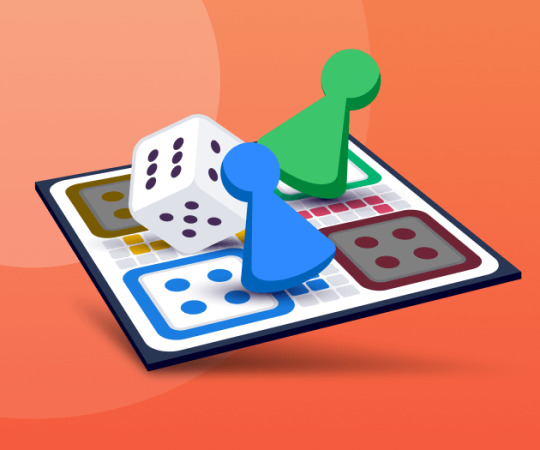
What Is Ludo?
Ludo is a strategy board game involving 2 to 4 players. Players race their tokens around the board based on dice rolls, aiming to get all tokens "home" before their opponents. The game's simplicity makes it universally appealing and easy to digitize.
Step 1: Understand the Basics of Ludo Game Development
Before diving into the multiplayer aspect, it's crucial to understand how the game functions:
Game Rules: Ensure you grasp Ludo's rules, such as token movement, dice mechanics, starting positions, and winning conditions.
Game Components: A digital Ludo game includes a board, dice, tokens, and a user interface for interaction.
Step 2: Define the Core Features
Multiplayer Ludo games thrive when they offer engaging and smooth gameplay. Here are some must-have features:
Player Modes:
Local Multiplayer: Multiple players sharing a single device.
Online Multiplayer: Connect players via the internet.
AI Opponents: Provide a single-player mode with computer-controlled opponents.
Real-Time Gameplay:
Players should be able to roll the dice and move tokens seamlessly without delays.
Cross-Platform Compatibility:
The game should run smoothly on Android, iOS, and web platforms.
Custom Rooms:
Allow players to create private game rooms to play with friends.
Chat Functionality:
Include an in-game chat for better user interaction.
Step 3: Choose the Right Tech Stack
Selecting the right tools and frameworks is vital for smooth development:
Game Engine: Unity or Unreal Engine are popular choices for game development.
Programming Language: C# (for Unity) or C++ (for Unreal Engine).
Networking Tools: Photon, Firebase, or PlayFab for real-time multiplayer functionalities.
Graphics: Tools like Adobe Photoshop or Illustrator for designing game elements.
Backend: Node.js or Python for server-side logic and database management.
Step 4: Develop the Game
Follow these steps to start building your Ludo game:
1. Create the Board and UI
Design the Ludo board and tokens based on the classic format.
Implement an intuitive user interface for easy navigation.
2. Implement Game Logic
Write code for:
Dice rolling and random number generation.
Token movement rules, including valid moves and token captures.
Winning conditions.
3. Add Multiplayer Features
Multiplayer features involve integrating networking functionalities:
Use Photon or similar tools for real-time player communication.
Implement a server-client architecture for smooth gameplay.
Enable matchmaking to connect players with similar skill levels.
4. Test for Latency and Connectivity
Multiplayer games rely heavily on stable connections. Test extensively for:
Lag in dice rolls or token movements.
Connection drops during matches.
Syncing issues between players.
5. Integrate Social Features
Allow players to invite friends, share achievements, and engage in leaderboards.
Step 5: Focus on User Experience
A good Ludo game isn't just functional; it’s enjoyable. Focus on:
Graphics and Animations: Smooth token movements and visually appealing board designs.
Sound Effects: Add dice roll sounds and background music.
Responsive Design: Ensure gameplay is smooth across different devices and screen sizes.
Step 6: Monetize Your Game
To make your Ludo game profitable, consider these monetization methods:
Ads: Show banner or rewarded ads during gameplay.
In-App Purchases: Offer players custom dice, board skins, or tokens.
Subscriptions: Introduce premium memberships with ad-free experiences and exclusive features.
Step 7: Launch and Market Your Game
Once the game is ready, launch it on major platforms like Google Play Store and Apple App Store. Use the following strategies to attract players:
Social Media Campaigns: Promote your game on platforms like Instagram, Facebook, and TikTok.
Influencer Marketing: Collaborate with gamers and streamers to showcase your game.
App Store Optimization (ASO): Use relevant keywords and high-quality visuals for better discoverability.
Step 8: Maintain and Update the Game
Post-launch, continuously improve the game by:
Fixing bugs and improving performance.
Adding new features or themes.
Engaging with player feedback to enhance the user experience.
Conclusion
Multiplayer Ludo game development is an exciting venture for beginners looking to break into the gaming industry. By following the steps outlined in this guide, you can create a fun, engaging, and profitable game that appeals to a global audience. Remember, success comes from continuous learning, testing, and updating your game to meet player expectations. Good luck with your development journey!
0 notes
Text
Color Prediction Game Development
How to Develop a Color Prediction Game: A Step-by-Step Guide
Color prediction games are engaging, simple to play, and popular among mobile users for their easy mechanics and fun nature. In a color prediction game, players usually select a color or a group of colors and bet on whether their chosen color will be the winning one. The simplicity of the game is what makes it appealing to a broad audience. If you’re interested in developing your own color prediction game, this article will walk you through the process from planning to deployment.
Understanding the Game Mechanics A color prediction game is based on straightforward mechanics, similar to a guessing game. Players place bets on colors, and after a random selection or spin, one color is chosen as the winner. Depending on the chosen color, players can win rewards or points. Key features typically include:
Color Selection: Players choose from available colors (usually a small, vibrant palette). Bet Placement: Players place a bet or select a stake for their chosen color. Randomized Outcome: The winning color is randomly selected through an algorithm. Rewards and Points: Winners receive rewards based on their stake and the game rules. To ensure fairness and prevent predictability, the randomization algorithm must be secure and unbiased.
Planning the Game Design Start by defining the game flow and user interface. It should be simple, visually appealing, and user-friendly. Consider the following elements for your design:
Home Screen: This should display options to log in, view recent winners, check current color odds, and place bets. Color Selection Screen: This is where players choose their color(s) and place their bet. Result Screen: This displays the winning color and rewards. Wallet or Balance Screen: Allows players to see their points or virtual currency balance. Additionally, you may want to include notifications for big wins, timers for game rounds, and clear instructions to help new players understand the game.
Choosing the Right Technology Stack For a color prediction game, a basic tech stack might include:
Frontend: HTML, CSS, and JavaScript for a web-based game, or Flutter/React Native for a cross-platform mobile app. Backend: Node.js, Python, or PHP for server-side logic and to handle user data. Database: MySQL, MongoDB, or Firebase for storing user profiles, scores, and transaction history. Random Number Generator (RNG): A secure RNG algorithm to select winning colors fairly. Libraries like Crypto in Node.js or Math.random in JavaScript can work, but ensure your choice aligns with your security requirements. You can host the game on AWS or Firebase for easy scalability and reliability.
Development Steps Here’s a step-by-step outline to get started with coding and assembling the game:
a) Build the User Interface The UI should be engaging and colorful. For the color selection and bet placement screens, use bright colors to make it visually appealing. Buttons, icons, and progress indicators should be easy to interact with, especially for mobile users.
b) Implement Core Game Logic The core logic includes allowing players to select a color, place a bet, and then use RNG to determine the winning color. Here’s a simple breakdown of how the logic flows:
Color Selection and Bet Confirmation: Players select a color and place their bet. Timer Start: A countdown timer starts, after which the game will choose a winning color. Random Color Selection: At the end of each round, the game randomly selects a color. Reward Distribution: If a player’s selected color matches the winning color, they receive points or rewards based on the stake. c) Create a Secure Random Number Generator (RNG) The RNG is the heart of this game. For a fair game, make sure the RNG is tamper-proof. Use a secure method to prevent predictable results, especially if there are rewards involved. For example, you can use Node.js’s built-in Crypto module for secure randomization.
d) Implement Rewards and Balance System For players who win, the system should calculate rewards based on their bet. This may involve multiplying their bet by a certain factor or distributing virtual currency. Keep track of each player’s balance, wins, and losses, and make this information accessible in their profile.
e) Set Up a Database Your database will store player data, game history, and transaction records. Use secure methods to store sensitive information and follow best practices for data security.
Testing and Refining the Game Testing is essential for a smooth gaming experience. Test your game for:
Randomization Accuracy: Ensure your RNG works correctly and produces fair outcomes. User Interface: The UI should be responsive and easy to navigate. Scalability: Test with multiple users to make sure the game server can handle traffic smoothly. Reward Distribution: Verify that rewards and points are calculated and distributed accurately.
Launching the Game Once testing is complete, prepare for deployment. If it’s a web game, ensure your server can handle the expected traffic. If it’s a mobile app, follow the guidelines for publishing on app stores. Before launching, create a promotional strategy to attract users. Social media, influencer partnerships, or even ads within other gaming apps can help you reach a broad audience.
Adding Engaging Features Post-Launch To keep users engaged, consider adding features like:
Leaderboards: Display top players to foster a sense of competition. Achievements and Daily Rewards: Provide incentives for regular play. Multiplayer Mode: Allow players to join games with friends for added fun. Seasonal Themes: Offer limited-time themes and bonuses for holidays and events. Final Thoughts Creating a color prediction game involves a blend of creativity, coding skills, and strategic planning. By focusing on a user-friendly interface, secure game mechanics, and engaging features, you can create a game that keeps players coming back for more.
For more info = https://fulminoussoftware.com/
0 notes
Text
Can somebody provide step by step to learn Python for data science?
Step-by-Step Approach to Learning Python for Data Science
1. Install Python and all the Required Libraries
Download Python: You can download it from the official website, python.org, and make sure to select the correct version corresponding to your operating system.
Install Python: Installation instructions can be found on the website.
Libraries Installation: You have to download some main libraries to manage data science tasks with the help of a package manager like pip.
NumPy: This is the library related to numerical operations and arrays.
Pandas: It is used for data manipulation and analysis.
Matplotlib: You will use this for data visualization.
Seaborn: For statistical visualization.
Scikit-learn: For algorithms of machine learning.
2. Learn Basics of Python
Variables and Data Types: Be able to declare variables, and know how to deal with various data types, including integers, floats, strings, and booleans.
Operators: Both Arithmetic, comparison, logical, and assignment operators
Control Flow: Conditional statements, if-else, and loops, for and while.
Functions: A way to create reusable blocks of code.
3. Data Structures
Lists: The way of creating, accessing, modifying, and iterating over lists is needed.
Dictionaries: Key-value pairs; how to access, add and remove elements.
Sets: Collections of unique elements, unordered.
Tuples: Immutable sequences.
4. Manipulation of Data Using pandas
Reading and Writing of Data: Import data from various sources, such as CSV or Excel, into the programs and write it in various formats. This also includes treatment of missing values, duplicates, and outliers in data. Scrutiny of data with the help of functions such as describe, info, and head.
Data Transformation: Filter, group and aggregate data.
5. NumPy for Numerical Operations
Arrays: Generation of numerical arrays, their manipulation, and operations on these arrays are enabled.
Linear Algebra: matrix operations and linear algebra calculations.
Random Number Generation: generation of random numbers and distributions.
6. Data Visualisation with Matplotlib and Seaborn
Plotting: Generation of different plot types (line, bar, scatter, histograms, etc.)
Plot Customization: addition of title, labels, legends, changing plot styles
Statistical Visualizations: statistical analysis visualizations
7. Machine Learning with Scikit-learn
Supervised Learning: One is going to learn linear regression, logistic regression, decision trees, random forests, support vector machines, and other algorithms.
Unsupervised Learning: Study clustering (K-means, hierarchical clustering) and dimensionality reduction (PCA, t-SNE).
Model Evaluation: Model performance metrics: accuracy, precision, recall, and F1-score.
8. Practice and Build Projects
Kaggle: Join data science competitions for hands-on practice on what one has learnt.
Personal Projects: Each project would deal with topics of interest so that such concepts may be firmly grasped.
Online Courses: Structured learning is possible in platforms like Coursera, edX, and Lejhro Bootcamp.
9. Stay updated
Follow the latest trends and happenings in data science through various blogs and news.
Participate in online communities of other data scientists and learn through their experience.
You just need to follow these steps with continuous practice to learn Python for Data Science and have a great career at it.
0 notes
Text
Stone Paper Scissors Game in Python
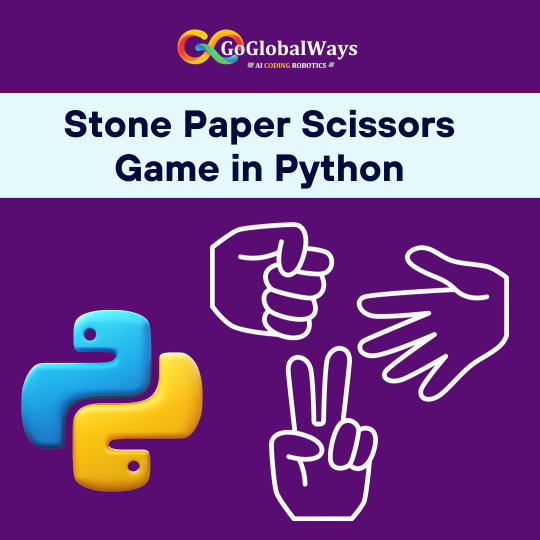
In the realm of coding, creating a Stone-Paper-Scissors game in Python is a delightful exercise that combines logic and user interaction. This classic game pits three elements against each other, challenging players to predict their opponent's move. Utilizing Python's simplicity, the code involves conditional statements to determine the winner based on the chosen elements. The program prompts users to input their choice, validating against the predefined options (stone, paper, or scissors). A random selection is generated for the computer, creating an unpredictable adversary. The comparison of choices unfolds through if-else conditions, revealing the game's outcome. Python's input/output functions make it engaging for players to participate actively. The Stone Paper-Scissors game in Python project serves as a fantastic introduction to fundamental programming concepts, fostering logical thinking and enhancing coding skills. Its interactive nature and visual appeal make it an ideal choice for beginners to grasp essential coding structures and encourage further exploration in the world of programming.
0 notes
Text
'RANDOM' Customized Dennis Rodman Jersey
Dennis Rodman was well-known for his colorful hairstyles, rebellious attitude, cross-dressing, and a whole host of other eccentric things that made him one of the wildest and greatest NBA icons in history. He is still known as one of the top rebounders the NBA has ever seen, a five-time NBA Champion. He pushed boundaries, did things his own way, which made people truly appreciate the randomness of his character. Ironically, Rodman is an anagram for the word random and so we customized these authentic Mitchell & Ness Chicago Bulls jerseys with random hair-on hides and skins. Cheetah, jaguar, bull, and dyed green zebra hair-on hides, embossed python and crocodile remind us of Rodman’s uniquely dyed hair and painted finger nails. Our uniquely placed red tag gives the piece our own custom authentic touch.
These elements are professionally stitched, embroidered and numbered with your selected number. It is bagged and boxed in our specially packaged and personalized box.
Size Information
Our jerseys are sized by the manufacturer to licensed specifications with a +2 in length. Most sizes run from small to XXL. This jersey runs from XXS to XXL. Jersey fit depends on your height, size, and build. We recommend that you go to your local sportswear store and try on a size that fits best for you prior to purchasing one of our pieces. For a general idea of size the below sizing chart can aid you in finding the right fit for you.
All suggested sizing depends on body type and fit preference. We are not accountable if you order a size that does not fit you as you prefer, so please be mindful when you order.
8 notes
·
View notes
Text
Master NumPy Library for Data Analysis in Python in 10 Minutes
Learn and Become a Master of one of the most used Python tools for Data Analysis.
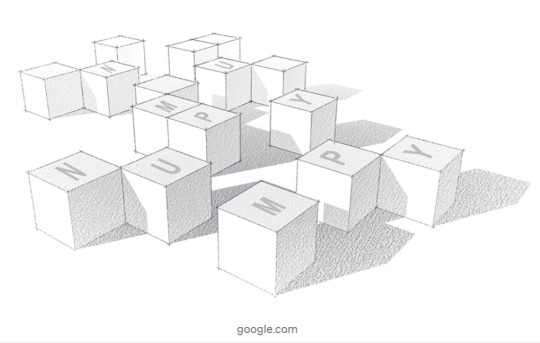
Introduction:-
NumPy is a python library used for working with arrays.It also has functions for working in domain of linear algebra, fourier transform, and matrices.It is an open source project and you can use it freely. NumPy stands for Numerical Python.
NumPy — Ndarray Object
The most important object defined in NumPy is an N-dimensional array type called ndarray. It describes the collection of items of the same type. Items in the collection can be accessed using a zero-based index.Every item in an ndarray takes the same size of block in the memory.
Each element in ndarray is an object of data-type object (called dtype).Any item extracted from ndarray object (by slicing) is represented by a Python object of one of array scalar types.
The following diagram shows a relationship between ndarray, data type object (dtype) and array scalar type −
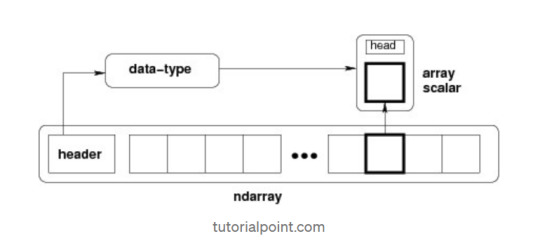
It creates an ndarray from any object exposing array interface, or from any method that returns an array.
numpy.array(object, dtype = None, copy = True, order = None, subok = False, ndmin = 0)
The above constructor takes the following parameters −
Object :- Any object exposing the array interface method returns an array, or any (nested) sequence.
Dtype : — Desired data type of array, optional.
Copy :- Optional. By default (true), the object is copied.
Order :- C (row major) or F (column major) or A (any) (default).
Subok :- By default, returned array forced to be a base class array. If true, sub-classes passed through.
ndmin :- Specifies minimum dimensions of resultant array.
Operations on Numpy Array
In this blog, we’ll walk through using NumPy to analyze data on wine quality. The data contains information on various attributes of wines, such as pH and fixed acidity, along with a quality score between 0 and 10 for each wine. The quality score is the average of at least 3 human taste testers. As we learn how to work with NumPy, we’ll try to figure out more about the perceived quality of wine.
The data was downloaded from the winequality-red.csv, and is available here. file, which we’ll be using throughout this tutorial:
Lists Of Lists for CSV Data
Before using NumPy, we’ll first try to work with the data using Python and the csv package. We can read in the file using the csv.reader object, which will allow us to read in and split up all the content from the ssv file.
In the below code, we:
Import the csv library.
Open the winequality-red.csv file.
With the file open, create a new csv.reader object.
Pass in the keyword argument delimiter=";" to make sure that the records are split up on the semicolon character instead of the default comma character.
Call the list type to get all the rows from the file.
Assign the result to wines.
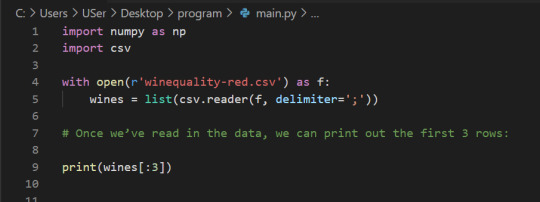

We can check the number of rows and columns in our data using the shape property of NumPy arrays:
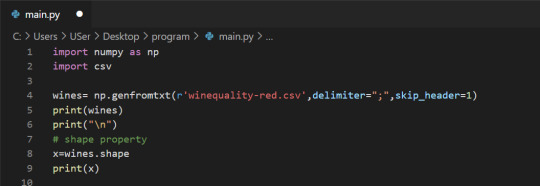
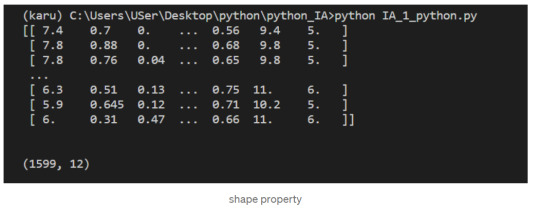
Indexing NumPy Arrays
Let’s select the element at row 3 and column 4. In the below code, we pass in the index 2 as the row index, and the index 3 as the column index. This retrieves the value from the fourth column of the third row:
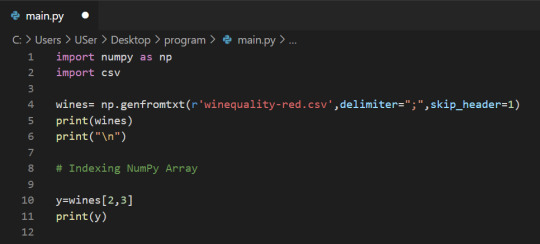
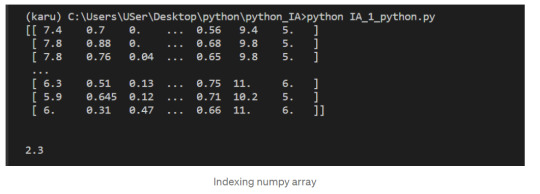
1-Dimensional NumPy Arrays
So far, we’ve worked with 2-dimensional arrays, such as wines. However, NumPy is a package for working with multidimensional arrays. One of the most common types of multidimensional arrays is the 1-dimensional array, or vector.
1.Just like a list of lists is analogous to a 2-dimensional array, a single list is analogous to a 1-dimensional array. If we slice wines and only retrieve the third row, we get a 1-dimensional array:
2. We can retrieve individual elements from third_wine using a single index. The below code will display the second item in third_wine:
3. Most NumPy functions that we’ve worked with, such as numpy.random.rand, can be used with multidimensional arrays. Here’s how we’d use numpy.random.rand to generate a random vector:
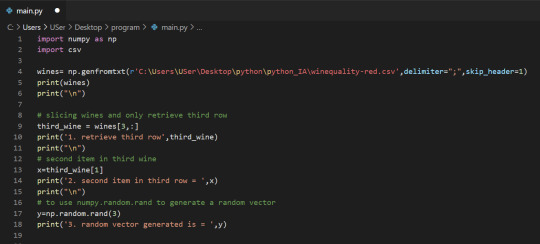
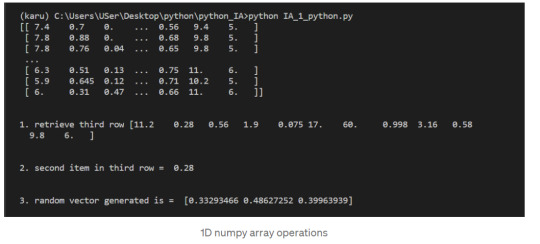
After successfully reading our dataset and learning about List, Indexing, & 1D array in NumPy we can start performing the operation on it.
The first element of each row is the fixed acidity, the second is the volatile ,acidity, and so on. We can find the average quality of the wines. The below code will:
Extract the last element from each row after the header row.
Convert each extracted element to a float.
Assign all the extracted elements to the list qualities.
Divide the sum of all the elements in qualities by the total number of elements in qualities to the get the mean.
NumPy Array Methods
In addition to the common mathematical operations, NumPy also has several methods that you can use for more complex calculations on arrays. An example of this is the numpy.ndarray.sum method. This finds the sum of all the elements in an array by default:
2. Sum of alcohol content in all sample red wines

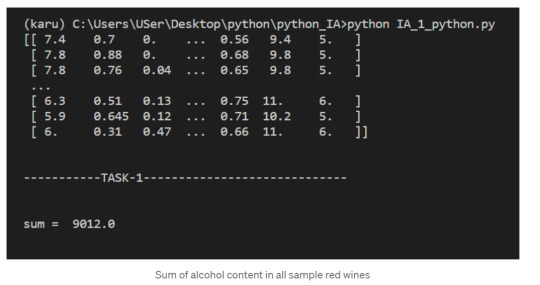
NumPy Array Comparisons
We get a Boolean array that tells us which of the wines have a quality rating greater than 5. We can do something similar with the other operators. For instance, we can see if any wines have a quality rating equal to 10:
3. select wines having pH content > 5

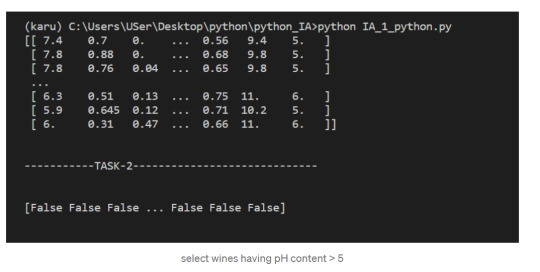
Subsetting
We select only the rows where high_Quality contains a True value, and all of the columns. This subsetting makes it simple to filter arrays for certain criteria. For example, we can look for wines with a lot of alcohol and high quality. In order to specify multiple conditions, we have to place each condition in parentheses, and separate conditions with an ampersand (&):
4. Select only wines where sulphates >10 and alcohol >7
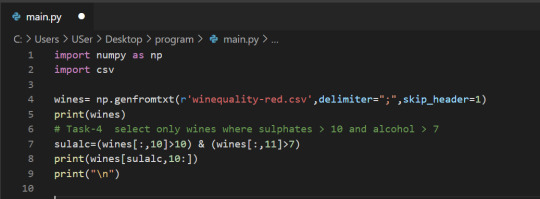
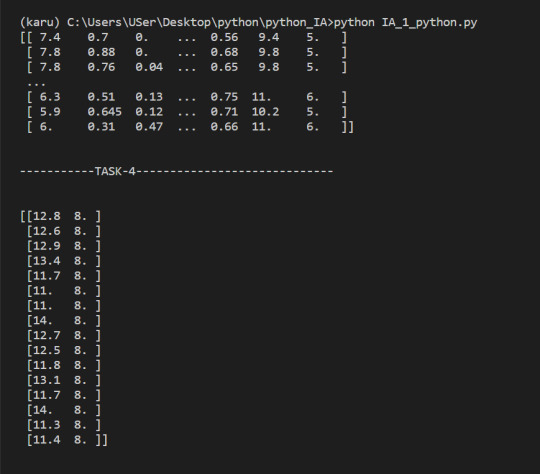
5. select wine having pH greater than mean pH
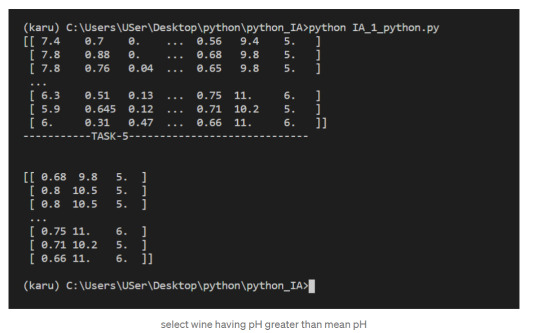
We have seen what NumPy is, and some of its most basic uses. In the following posts we will see more complex functionalities and dig deeper into the workings of this fantastic library!
To check it out follow me on tumblr, and stay tuned!
That is all, I hope you liked the post. Feel Free to follow me on tumblr
Also, you can take a look at my other posts on Data Science and Machine Learning here. Have a good read!
1 note
·
View note
Text
Driving lesson planner

#Driving lesson planner how to#
#Driving lesson planner full#
To succeed in this course, you should have programming experience in Python 3.0, and familiarity with Linear Algebra (matrices, vectors, matrix multiplication, rank, Eigenvalues and vectors and inverses) and calculus (ordinary differential equations, integration). This is an intermediate course, intended for learners with some background in robotics, and it builds on the models and controllers devised in Course 1 of this specialization. You'll face real-world randomness and need to work to ensure your solution is robust to changes in the environment.
#Driving lesson planner full#
This course will give you the ability to construct a full self-driving planning solution, to take you from home to work while behaving like a typical driving and keeping the vehicle safe at all times.įor the final project in this course, you will implement a hierarchical motion planner to navigate through a sequence of scenarios in the CARLA simulator, including avoiding a vehicle parked in your lane, following a lead vehicle and safely navigating an intersection. Looking For Driving instructor Lesson Plans If you are looking for driving instructor lesson plan briefing sheets we can help.
#Driving lesson planner how to#
Our free driving lesson plans offer you a simple, easy to understand guide on how to drive. You'll also build occupancy grid maps of static elements in the environment and learn how to use them for efficient collision checking. The most important thing to us here at The Driving School South West, is teaching you the skill of safe driving for life as efficiently and cost effectively as possible. By the end of this course, you will be able to find the shortest path over a graph or road network using Dijkstra's and the A* algorithm, use finite state machines to select safe behaviors to execute, and design optimal, smooth paths and velocity profiles to navigate safely around obstacles while obeying traffic laws. This course will introduce you to the main planning tasks in autonomous driving, including mission planning, behavior planning and local planning. Welcome to Motion Planning for Self-Driving Cars, the fourth course in University of Toronto’s Self-Driving Cars Specialization. Welcome to Motion Planning for Self-Driving Cars, the fourth course in University of Toronto’s Self-Driving Cars Specialization.

1 note
·
View note
Text
How to Start an Online Ludo Game Business in India?

Ludo is one of the most played games in the gaming market and this flourishes tons of Ludo game mobile applications. According to the experts, there are a couple of reasons which are the major drivers of the industry’s success. There is the increased use of electronic gadgets and the internet. Furthermore, we are now aware of the digitalization of our daily lives due to the Covid led pandemic, which has increased the number of players who respond to start an Online Ludo Game Business.
What is Online Ludo?
Online Ludo Game is based on the traditional Ludo Game which we loved to play in our childhood that allows players worldwide to come and compete with each other. It provides an array of options, and in addition to random players, one can play with computer-generated players.
Future of Online Ludo Business
Experts believe that the popularity of the Online Ludo Business will continue to climb in the future. This claim is also validated by the growing number of Online Ludo Software Businesses. As a result, this business opportunity is a potential investor’s dream. However, this is also a commercial effort, and one must be mindful of the industry’s scale and possible risks. If you are planning to Start an Online Ludo Game Business, this article will walk you through every step of what to do and what not to do in the Ludo Game Business.
Steps to Start An Online Ludo Game Business in India
Starting an Online Ludo Game Business, like any other business, entails fundamental market research, which sets the prerequisite of business enterprise. Furthermore, one must be mindful of your budget, which will dictate your action path again. The following elements are interconnected and follow an appropriate and sensible order that will assure the success of your Online Ludo Game Business.
1. Researching About the Market Potential
Establishing a business is a complicated process, and even before you begin constructing the Ludo game business, you must first identify the relevance and potential of the gaming market. Before deciding on a market, ensure that it has many potential participants for your online Ludo Game, and it will be highly advantageous to your business and assure its growth.
2. Determine Your Target
The second step is to decide the kind of players you want to attract, such as adults, children, or the elderly. It should note that the Online Ludo Game only generates revenue when a huge number of people visit your website. This target will influence your choice of the kind and features of the Ludo gaming website you will use for your Online Ludo Game business. You must also ensure that your Ludo game is accessible to your customers.
3. Investigate your Competition
Before launching your own Online Ludo Game Business, research the prospective services that your rivals offer and develop and arrange your Online Ludo Game properly. Always strive to provide unique features that set your Ludo Game Business apart from the competition. It will give a fresh experience for consumers and greatly benefit your Online Ludo Game business in the long term by bringing in new clients.
4. Make a Budget
Examine the entire expenditures of creating and constructing the game website or mobile app for your Online Ludo Game Business. Because you are aware of your financial resources, it should be easy to select the firm that best fits your needs. It would help if you are looking for a Ludo game business that can provide elevated, reliable, and dedicated servers capable of handling the traffic created by your website. If you want to Spend Less then you can also Hire dedicated developers for all the trending industries; Android, iOS, Kotlin, Python, and whatnot, our offshore dedicated developers in India possess mastery in all major technologies to boost your online business.
5. Ascertain the Software
You must also select Ludo Game Software that best fulfills and caters to your Online Ludo Game website or mobile application requirements. Following this, prepare the content and carefully choose a website that attracts players and holds their interest for an extended time, therefore interacting with more prospective clients.
6. Choose Ludo Game Software Provider
Many Ludo Game Development companies operate in the market that offers Ludo Game Software but are aware of your platform’s requirements. So, be extremely cautious while selecting the Ludo Game business that will create the Online Ludo Game Software for you. An experienced and dependable firm that has worked with the Ludo Game Business will be more beneficial to you. Furthermore, you know that two operating systems, Android and iOS, account for the great majority of the smartphone business. Therefore, you will have to construct each app separately, which might be costly. Consequently, choose a Ludo Game Development company with expertise in building applications for both of these platforms.
7. Follow the Legal Procedure
Your Online Ludo Game should provide customers with a fun, imaginative, and exciting gaming experience. Consider all of the rules and requirements associated with the Ludo Game Business, such as GST registration, which, once completed, will save your clients from any unnecessary future troubles. It will progressively improve your market reputation and broaden your firm’s reach.
8. Promotion and Marketing
Promoting and advertising your Online Ludo Game Software is critical in this competitive online game industry. To encourage your Ludo Game Business online, you may utilize digital marketing campaigns. And tactics, as well as hiring specialist staff. Create impactful advertisements that will fascinate your target audience. Furthermore, your website that serves the Online Ludo Game should be simple to use and entertain the users.
9. Ensure Safety and infallible Customer Service
Always invest in entirely secure payment systems for your online gaming business. Consumers usually emphasize safety when selecting any gaming platform. As a result, your Online Ludo Game should be able to give clients a smooth and secure trip. Customers will spend more time on your website if you have dedicated customer service and an excellent customer care mechanism. The team handling this aspect of your business should guide your customers and always refer them regarding any technical difficulty. It shall satiate your customers, and eventually, your business will boom.
Concluding Lines:
Although it may appear to be a lot at first, there are reputable firms on the market that will significantly simplify your task. You may, for example, choose Agnito Technologies as your Online Ludo Software supplier. We have extensive experience in this industry like rummy game development and will develop your website and application at a market-competitive price. Our core technical staff is committed to offering impeccable services to our clients. And we guarantee that your experience will be unforgettable.
#ludo game development#Ludo Game Development Company#rummy game development company#Rummy Game Development#card game development company#card games
0 notes
Text
The Foundations of Gambling Application Development: Key Considerations and Best Practices
The initial stages of developing a gambling application are crucial for setting the foundation of a successful and sustainable platform. As the gambling industry continues to shift toward digital solutions, the demand for innovative, secure, and user-friendly applications has never been higher. However, creating a gambling app involves navigating a complex landscape of technical, regulatory, and user experience challenges. From selecting the right technology stack to ensuring compliance with legal requirements, the early phases of development require careful planning and execution.
One of the first steps in developing a gambling application is defining the core features and target audience. Whether the app focuses on casino games, sports betting, or poker, understanding the user base is essential for designing a product that meets their needs. For instance, a sports betting app might prioritize features like live odds updates, in-play betting, and push notifications, while a casino app might emphasize slot machines, table games, and bonus systems. Conducting market research and user persona analysis can help developers identify the most valuable features and create a roadmap for the project.
Choosing the right technology stack is another critical decision in the initial development phase. For the frontend, modern JavaScript frameworks like React, Angular, or Vue.js are popular choices due to their ability to create dynamic, responsive, and interactive user interfaces. These frameworks enable developers to build seamless experiences across devices, from desktops to mobile phones. On the backend, technologies like Node.js, Python, or Ruby on Rails are often used for their scalability and efficiency in handling real-time data and transactions. Additionally, WebSocket technology is essential for enabling real-time communication, such as live game updates or multiplayer interactions.
Security is a top priority in gambling app development, and it must be addressed from the very beginning. Implementing end-to-end encryption (E2EE) ensures that sensitive data, such as payment information and user credentials, is protected from unauthorized access. Developers must also integrate two-factor authentication (2FA) and secure login mechanisms to prevent account breaches. Furthermore, compliance with GDPR, PCI DSS, and other regulatory standards is mandatory, requiring developers to adopt best practices like data anonymization, secure storage, and regular security audits. These measures not only protect users but also build trust in the platform.
Another key consideration in the initial development phase is ensuring fairness and transparency in gameplay. Gambling apps must incorporate Random Number Generators (RNGs) that are tested and certified by independent auditing bodies to guarantee unbiased outcomes. For blockchain-based platforms, provably fair algorithms can be implemented to allow users to verify the integrity of each transaction or game result. These features are essential for maintaining user trust and complying with industry regulations.
The user experience (UX) design of a gambling app plays a significant role in its success. A well-designed interface should be intuitive, visually appealing, and optimized for engagement. Developers often use UI/UX design tools like Figma or Sketch to create wireframes and prototypes, ensuring that the app’s layout and navigation are user-friendly. Features like personalized dashboards, gamification elements (e.g., leaderboards and rewards), and seamless transitions between screens can enhance user retention and satisfaction. Additionally, the app should be optimized for cross-platform compatibility, ensuring a consistent experience across iOS, Android, and web browsers.
Integrating payment gateways is another essential step in the initial development phase. Gambling apps must support a variety of payment methods, including credit cards, e-wallets, and cryptocurrencies, to cater to diverse user preferences. APIs from providers like Stripe, PayPal, and Coinbase can facilitate secure and efficient transactions. Developers must also implement KYC (Know Your Customer) and AML (Anti-Money Laundering) procedures to verify user identities and prevent fraudulent activities. These measures are critical for complying with regulatory requirements and maintaining the platform’s integrity.
Finally, the initial development phase should include planning for scalability and performance optimization. As the user base grows, the app must be able to handle increased traffic and data loads without compromising performance. Cloud-based infrastructure and Content Delivery Networks (CDNs) can help distribute content efficiently and reduce latency. Additionally, developers should implement caching strategies and lazy loading techniques to minimize resource usage and improve load times.
In conclusion, the initial stages of gambling application development are foundational to the success of the platform. By carefully defining features, selecting the right technology stack, prioritizing security and fairness, and designing an engaging user experience, developers can create a robust and competitive product. As the gambling industry continues to evolve, these early decisions will shape the app’s ability to adapt to new trends, technologies, and regulatory requirements, ensuring its long-term success in a dynamic and competitive market.
Make order from us: @UICAstudent
Our portfolio: https://www.linkedin.com/company/chimeraflow
0 notes
Text
How to Develop a Ludo Game App with a Multiplayer Feature

With mobile gaming, traditional board games like Ludo have entered the digital age, reaching millions of players across the globe. Ludo game development is an exciting opportunity for businesses and developers who wish to tap into this growing trend. Adding a multiplayer feature takes the experience to the next level, enabling players to connect and compete in real time. The article focuses on developing a Ludo game app with multiplayer; it includes all the steps, technologies, and challenges that have to be taken into consideration.
Understanding Ludo Game Development
Ludo game development means creating a digital version of the classic board game, which includes engaging gameplay and user-friendly design. The multiplayer feature is the most vital component because it replicates the social aspect of the traditional game. Popular apps like Ludo King and Ludo Club have shown how multiplayer functionality can increase user retention and engagement.
The potential focus for developing Ludo games will make you create a unique app appealing to the demand while coming across as unique in a competitive market.
Key Features of a Multiplayer Ludo Game App
When designing a multiplayer Ludo game, incorporating the right features ensures a seamless user experience:
Real-Time Multiplayer Functionality
A robust multiplayer system allows players to join games in real time, either with friends or random opponents. This feature requires reliable servers to handle player interactions without latency issues.
Cross-Platform Compatibility
Modern gamers use various devices, so your Ludo app should be compatible with Android, iOS, and web platforms. Cross-platform support ensures that players can compete regardless of their device.
User Authentication and Profiles
Secure login options (via email, social media, or mobile numbers) and user profiles allow players to save progress and build their game identity.
Chat and Social Features
In-game chat, emojis, and friend invites create a lively gaming atmosphere, which enhances the multiplayer experience.
Technology Stack for Ludo Game Development
Selecting the right technology stack is essential for building a high-performance multiplayer Ludo game app.
Game Engine
Engines like Unity or Unreal Engine are excellent choices for Ludo game development, as they offer robust tools for designing immersive game environments.
Backend and Server Infrastructure
A reliable backend powered by Node.js or Python and cloud-based servers like AWS or Firebase ensures smooth real-time gameplay.
Programming Languages
Choose Java or Kotlin for Android, Swift for iOS, and JavaScript for web compatibility.
Database Management
Use scalable databases like MongoDB or MySQL to manage user data and game progress.
Steps to Develop a Ludo Game App with a Multiplayer Feature
1. Conceptualization and Planning
Start by defining the core features and target audience for your app. Consider unique elements that set your app apart from competitors, such as special game modes or customization options.
2. Game Design and UI/UX Development
One more important thing to retain players is an intuitive and aesthetically pleasing interface. Cooperate with experienced designers to create a layout of the board, dice animations, and player avatars.
3. Development and Testing
Begin coding your app and integrating the multiplayer functionality during this stage. Real-time communication protocols like WebSocket are ideal for managing player interactions. Testing is critical to identify and fix bugs, optimize performance, and ensure compatibility across devices.
4. Deployment and Maintenance
Once your app is ready, deploy it on app stores and market it with some marketing campaigns. This is necessary to provide regular updates—new features as well as a bug fix—for those players to stay engaged.
Challenges in Ludo Game Development and Their Solutions
Developing a multiplayer Ludo game app comes with unique challenges:
Latency Issues:
Use low-latency protocols and efficient server management to provide a seamless experience.
Scalability:
Design your app to handle increasing user loads without compromising performance.
Security:
Implement encryption and secure authentication methods to protect user data.
Monetization Strategies for Multiplayer Ludo Games
To make your app profitable, consider these monetization strategies:
In-app Purchases:
Offer players additional dice rolls, avatar customizations, or premium game modes.
Advertisements:
Integrate ads strategically to generate revenue without disrupting gameplay.
Subscriptions:
Provide ad-free experiences or exclusive features through subscription models.
Conclusion
A multiplayer Ludo game app is a rewarding business venture because it combines the traditional board game charm with mobile gaming convenience. By making use of advanced technologies, designing user-friendly interfaces, and addressing common challenges, you can create an app that captivates players around the world.
If you need professional assistance with Ludo game development, AIS Technolabs is the source to take it back into your vision. Our developers are experienced in creating engaging, feature-rich gaming apps specifically according to your requirements. Contact us today!
FAQs
1. What is the estimated cost of developing a Ludo game app?
Costs also vary with features, design complexity, and compatibility over some platforms. It usually starts between $10,000 and $50,000.
2. How can I ensure a smooth multiplayer experience in my Ludo app?
Invest in strong infrastructures for servers, light communicational protocols, and sufficient tests to reduce the glitches on launch day.
3. What are the top features of a multiplayer Ludo game?
Real-time gameplay, cross-platform support, user authentication, and social features like chat are essential for a multiplayer Ludo app.
4. How long does it take to develop a Ludo game app?
Development time can vary, but most Ludo apps with multiplayer features take 4–8 months to complete.
5. Why should I choose AIS Technolabs for Ludo game development?
AIS Technolabs offers expert developers, a client-focused approach, and proven experience in delivering top-notch gaming solutions.
Blog Source: https://ludo-game-app.hashnode.dev/how-to-develop-a-ludo-game-app-with-a-multiplayer-feature
0 notes
Note
meet the selfshipper game but ALL OF THEM I am requesting all of them bc I want to know you
if u insist!!! tee hee
🎨 - Top 3 favorite colors?: Pink, Blue, and Yellow in that order! I prefer light tones/pastels :) 🎮 - Top 3 favorite hobbies?: Art, Writing, and gaming!
👔 - How would you describe your personal style?: pastel punk w elements of fairy kei/kawaii fashion
🐶 - Do you own any pets? If not, do you have a dream pet?: I do not! I've love to have a ball python and some other snakes, and a cat! ✨ - What are your top 3 current special interests?: I've been hyperfixating on a whole bunch of things lately! The main one is of course God of War tho :D 🍿 - Favorite and least favorite foods?: I like chicken and steak I guess! Im a very selective eater and i dislike most foods! 🥇 - What are you most proud of yourself for?: Shit dog idk! Being here I guess??? ✈️ - Top 3 dream travel destinations?: I'd love to go back to PEI, and I would love to see Ireland and Germany. 💵 - What are some goals you have for your life?: Be financially comfy and have my name be known in some way i guess! 🧸 - Is there anyone who inspires you? Who are they and why?: Never really thought about it tbh. ❤️🩹 - What’s a piece of advice you’d like to share?: Go to the doctor before you physically can't! You'll be much healthier that way!
🌼 - Give us a cool random fact about you!: I like possumz
#im not that interesting i think lol#also ignore that im answering this at 1:45am i. forgot#jamie answers#mnyehlike#ask game
1 note
·
View note
Text
ICM Week 1 HW: Reflection
How does computation apply to my interests?
My background was originally in International Relations (that’s what I studied in college and I worked in Peru at a community health organization and a development policy research group), but for the past three years before coming to ITP, I worked at the University of Chicago Crime Lab doing crime and education policy research. As a Research Manager there, I managed the randomized controlled trial evaluations of two youth violence prevention programs: an in-school meditation program for high school students and a wraparound and CBT (cognitive behavioral therapy) program for adolescents at high risk of violence involvement. This work was part of a larger portfolio of projects at the UChicago Urban Labs to improve public programs and policies by applying methods from science. The goal of the Labs is to figure out what works and what doesn’t so that policymakers can make more informed decisions on how to best use public dollars to make progress on urban challenges related to health, crime, education, poverty, energy and the environment. Each piece of evidence gathered from these studies helps to build the collective body of knowledge on how to effectively address social issues that cities face.
In my role I worked with academics, policymakers, and non-profit leaders in the city, I analyzed Chicago Police Department and Chicago Public School data, I held focus groups with youth, I presented our results to funders, and in my spare time I audited classes at UChicago such as Machine Learning in Public Policy and Data Analysis with Python. At ITP, I am hoping to combine my knowledge in this area and these experiences with design, technology, and computing.
I think that computing has huge potential to change and improve our public life and democracy. In fact, I believe that the next technological revolution needs to be in governance. That’s why at ITP I want to focus on designing, developing and creating civic technologies. I am still working on a definition for what civic technology is, but have a few ideas that have started to solidify. To paraphrase Danielle Wood who is a researcher at the MIT Media Lab: Civic technologies are public sector systems – info or hardware – designed for public service.
I think that this is close, but think there is a key element missing. I have been a developing and tweaking a manifesto of sorts for the past few years as I’ve thought about these issues and so far have the following to add:
Most questions people ask about technology/computation are about how we can be more efficient, have access to more information, or get to places faster, but these are tools, not ends in themselves. I think we need to ask: how do we design systems that enable our best humanity? As I’ve learned more about the history of computing and lived through recent events (for example, when the internet did not herald a new age of democracy as some had predicted, and when the 2016 election revealed the isolation of our online communities), I have learned that technology is not capable of building just and equitable social systems on its own. That ability and responsibility is ours.
What projects do I imagine making?
For the past six months, I have been working on a project that I started at Chi Hack Night (a weekly civic hacking meet-up in Chicago) to create a website that aggregates civic events around Chicago. Currently, there isn’t one central place where people can access this information. Beyond simply accessing information on civic events, my goal is for individuals to more easily integrate civic participation into their daily lives, enable neighbors to connect and engage in dialogue offline, and help cities have more visibility into the needs of their citizens.
This semester I am also working with Pat Sharkey in the NYU Sociology department to help him further develop his website AmericanViolence.org. It is meant to be a tool for researchers, journalists, policymakers and citizens to easily access and understand information on violence around the country. I will be working as a project manager but hope to also contribute to web development, data visualization and analysis.
Within civic technology, I am particularly interested in understanding human-human interaction and communicating results. In ICM, I could imagine creating something related to one of the projects mentioned above. For example, a tool that tracks and records civic engagement (a “civic health” tracker of sorts) or a data visualization on a social justice issue.
More generally at ITP, I hope to develop and study tools that merge computing and visual design with social science to re-think how we conceive of our civic life. I could imagine applying computing to my interests in the following ways that are a bit more ambitious than what I could do in a semester:
Data visualizations and tools for data visualization/analysis
Machine learning in social science (optimizing policy decisions)
Tools for civic engagement/platforms to help people engage with cities and neighbors
Tools for helping people have better access to, better use public resources/social services
Augmented reality in public space – for both locals and tourists
Tools for policymakers to understand information quickly and make decisions (similar to the system Boston has)
Public interactive art installations
Crowdsourcing solutions to civic challenges
Built technologies in cities (“smart cities”)
Tools that make cities and public spaces more accessible (to people with disabilities and all people)
What am I inspired by?
Max Hawkins’s OffBot – This is an app like Yelp for finding restaurants, bars, etc., but it randomly selects the place once you’ve selected the neighborhood on the map. It’s a new and really interesting way of navigating cities that goes against the optimization movement.
Ani Liu’s projects (wonderinganimal on Instagram) – I am fascinated by the way she combines different disciplines (biology and computing for example) in such creative, imaginative, and thought provoking ways.
Joy Buolamwini – All her work and especially her Algorithmic Justice League. She started working on making better algorithms for facial recognition software when she realized that the computer couldn’t see her face because she’s not white.
Action Path – This was a thesis project by Erhardt Graeff in the Civic Media group at the MIT Media Lab. It allows community members to give feedback in real time and location specific on developments and issues happening in their neighborhood.
Sidewalk Labs – I am not convinced that a demonstration city is the best method for developing new technologies (I think it would be better to implement technologies in a more realistic setting), but I love and am inspired by how they are re-thinking every aspect of cities.
Pokémon Go – Not because I love Pokémon (although I did try to catch ‘em all in 2nd grade), but because I think it’s a great example of the potential for AR/MR in public space.
Dear Data – This is an “analog” data visualization project in which two women hand drew data visualizations using data they collected from their daily lives. Although it does not use computing, I am inspired by the concepts behind the work.
Janet Echelman – I love the net sculptures she makes that combine data, physical materials and computing. I think they are a beautiful form of live data visualization.
1 note
·
View note
Text
Data Science

As tools become simpler to make use of and the people who use them become more obtainable, the worth of Data Science will go down. Current infrastructures for developing big-data functions are able to course of –via big-data analytics- huge quantities of knowledge, utilizing clusters of machines that collaborate to perform parallel computations. However, present infrastructures were not designed to work with the requirements of time-critical applications; they're more targeted on general-purpose purposes than time-critical ones. Addressing this problem from the angle of the real-time methods group, this paper considers time-critical big-data.
The information in normal and defective conditions are simulated through the use of the DT model. Both the simulated knowledge and extracted historical knowledge are utilized to enhance fault prediction. A convolutional neural community for fault prediction might be trained with the generated data which matches the characteristic of the autoclave in defective conditions. The effectiveness of the proposed methodology is verified via result analysis. To stand out as a prolific Data Scientist being well versed in machine studying is important. Knowing the methods like logistic regression, decision timber, and so on. can aid the method.
In summary, data science may be due to this fact described as an applied branch of statistics. A large number of fields and subjects, starting from everyday life to conventional analysis fields (i.e., geography and transportation, biology and chemistry, medicine and rehabilitation) involve big information problems. The popularizing of assorted forms of community has diversified varieties, issues, and solutions for large data more than ever before. In this paper, we review current analysis in data sorts, storage fashions, privacy, data security, evaluation methods, and applications associated with network massive information. Finally, we summarize the challenges and development of huge knowledge to foretell present and future tendencies.
Data scientists are responsible for breaking down huge amounts of knowledge into usable information and creating software programs and algorithms that help corporations and organizations decide optimum operations. As knowledge continues to have a serious impression on the world, Data Science does as well due to the close relationship between the two. During the 1990s, in style terms for the method of discovering patterns in datasets included "knowledge discovery" and "data mining". We examine “citizen” data scientists and debate between Jeffersonians, who search to empower on an everyday basis worker with Data Science tools, and Platonists who argue that democratizing data science results in anarchy and overfitting. In the present world, the technology and utility of knowledge is a crucial economic activity. Data Science facilitates it with its power to extract info from massive volumes of information.
It has robust scalability and excessive processing efficiency and has utility and reference value. Data Science is the essence of deriving valuable insights from information. It is emerging to satisfy the challenges of processing very large datasets, i.e. Big Data, with the explosion of new knowledge constantly generated from various channels, similar to good gadgets, net, mobile and social media. Data science is expounded to data mining, machine studying and large data. Digital enterprise is considered one of the necessary and priceless industries' names today and it is the mixture of enterprise and IT elements and its uses.
Rather than performing the info science themselves, they need to prepare and guide the users in changing into self-sufficient. Organizations can establish a formal training program for customers who wish to become citizen Data Scientist. At the tip, customers receive a certification that enables them entry to the tools. As they gain more experience and data they will in turn mentor different business customers. This paper presents a movie recommendation system in accordance with scores that the users present. In view of the film evaluation system, the impacts of entry management and multimedia safety are analyzed, and a secure hybrid cloud storage structure is offered.
It deals with the definition of a time-critical big-data system from the point of view of requirements, analyzing the particular characteristics of some in style big-data applications. This evaluation is complemented by the challenges stemming from the infrastructures that help the functions, proposing an architecture and providing initial performance patterns that join software costs with infrastructure performance. Cloud computing is actually a mechanism used for virtualization IT resources software programs and hardware availability. Cloud computing helps in using less computer hardware together with IT Infrastructure delivery.Use of minimal software with utilization of applications can also be essential features of Cloud Computing and Applications.
This leads us to understand how guidelines of linear algebra operate over arrays of knowledge. We aim to propose some solutions for digital pictures safety, primarily utilizing a probabilistic-randomness method; chaotic maps & chance. Data scientists use Python and R for information preparation and statistical analysis. [newline]Compared to R, Python is used for common objectives, more readable, easier, and offers more flexibility than learning. Moreover, Python is used in a number of verticals apart from Data Science and presents you various purposes. Data Science facilitates firms to leverage social media content to obtain real-time media content material utilization patterns. This permits the companies to create target audience-specific content, measure content performance, and recommend on-demand content material.
By this I imply that there are some critical points that end result from handing these tools to the uninitiated. Such individuals need to combine area data and adequate data science course in hyderabad , presumably with certification”. Innovative data intensive functions similar to health, power, cybersecurity, transport, food, soil and water, sources, advanced manufacturing, environmental Change, and so forth.
In 1974, Peter Naur mentioned the term ‘Data Science’ a number of times in his evaluation, Concise Survey of Computer Methods. In 1977, the International Association for Statistical Computing was shaped to link trendy computer technology, conventional statistical methodology, and domain experience to transform knowledge into data. In the same 12 months, Tukey composed a paper, Exploratory Data Analysis, that briefed the importance of using information. If you’re also planning to explore your Data Science career with EXL, these EXL Data Science interview questions will assist you to prepare higher.
The proposed Hierarchical Multiresolution Time Series Representation model makes use of a buffer-based approach that mixes one-pass stream processing with hierarchical aggregation to attain excessive processing speed without extreme hardware necessities. In addition, this paper presents a brand new representation primarily based on the proposed model, Hierarchical Multiresolution Linear-function-based Piecewise Statistical Approximation. The proposed representation considers fluctuations and continuity of modeled processes to be able to preserve fundamental characteristics of time series at lowered dimensionality. The case study outcomes for the generated data set verify that the proposed mannequin leads to greater and more stable processing speed at decreasing RAM consumption evaluating a related model, particularly when coping with greater number of time resolutions. The case research results for real UK good meter knowledge verify that the proposed representation results in a reduced amount of information loss and an improvement in subsequent time series clustering compared to associated time sequence illustration.
When mixed with languages like Java, C and C++, python turns into extremely adaptive and suitable to make use of. An estimate of eighty eight % have a masters degree whereas forty eight percent have a doctorate. It has become necessary to have an excellent schooling to develop the required deep understanding of a big selection of matters. Most Data Scientists are well versed within the utilization of Hadoop and large knowledge queries. DSS was created to supply a prime worldwide forum for researchers, industry practitioners and domain experts to exchange the most recent advances in Data Science and Data Systems in addition to their synergy.
There is, however, a debate between two teams; Jeffersonians and Platonists. The Jeffersonians argue on behalf of the yeoman farmer, or in this case the yeoman scientist. Being deeply committed to the republicanism of science they are opposed to an aristocracy of knowledge, to an elitism of hackers, material consultants, and statisticians. This leads to higher choice making since they're getting into the details of the model and the info, creating a deeper understanding of what is driving their decisions. Forbes reported that “unicorn Data Scientists”, these special people who are subject matter specialists with hacking and statistical expertise, can earn $240,000 yearly.
2019 is the fifth event following the success in 2015 (DSDIS-2015), 2016 (DSS-2016), 2017 (DSS-2017) and 2018 (DSS-2018). There is still no consensus on the definition of Data Science and it is considered by some to be a buzzword. The existence of Comet NEOWISE was found by analyzing astronomical survey knowledge acquired by a space telescope, the Wide-field Infrared Survey Explorer. In order to reply to the outlined questions, descriptive statistics allows you to rework each statement in your data into insights that make sense. Common information buildings , writing capabilities, logic, control flow, looking out and sorting algorithms, object-oriented programming, and dealing with exterior libraries. Most data roles are programming-based apart from a number of things like business intelligence, market evaluation, product analyst, and so forth.
data science training in hyderabad
All the pieces have been really falling into place for Python data professionals. We are roughly a decade faraway from the beginnings of the modern machine learning platform, inspired largely by the growing ecosystem of open-source Python-based technologies for data scientists. It’s a good time for us to reflect back upon the progress that has been made, spotlight the most important problems enterprises have with existing ML platforms, and talk about what the subsequent generation of platforms shall be like. As we’ll focus on, we believe the following disruption within the ML platform market will be the growth of data-first AI platforms.
This comprises information that has undefined content and doesn’t fit databases like movies, blog posts, etc. There are exceptional resources to dive deep into math, but most of us aren't made for it, and one doesn’t have to be a gold medalist to learn Data Science. Every Data Science course that I enlisted there required college students to have an honest understanding of programming, math, or statistics. For instance,the most famous course on ML by Andrew Ng additionally depends heavily on the understanding of vector algebra and calculus. Calculus — derivatives and limits, by-product rules, chain rule , partial derivatives , the convexity of features, local/global minima, the math behind a regression model, applied math for coaching a mannequin from scratch.
For more information
360DigiTMG - Data Analytics, Data Science Course Training Hyderabad
Address - 2-56/2/19, 3rd floor,, Vijaya towers, near Meridian school,, Ayyappa Society Rd, Madhapur,, Hyderabad, Telangana 500081
099899 94319
https://g.page/Best-Data-Science
0 notes